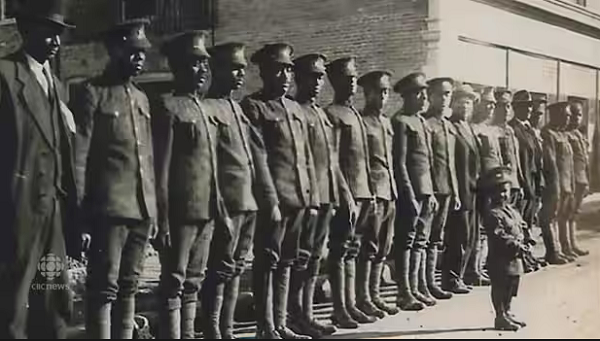GTA teacher made her own book after she couldn’t find books on First World War’s all Black battalion for her students
Serena Virk, a physical education and health teacher at Sawmill Valley Public School, was putting together a bulletin board for Remembrance Day a few years ago when she noticed a glaring hole in the resources available to younger students.
According to Virk, there weren’t many books on the contributions of Black Canadian soldiers during the First World War — and none about the No. 2 Construction Battalion.
So she made one.
“We Remember the Black Battalion” is a picture book, illustrated by Arnab Das, with Virk’s free-verse poem telling the story of the No. 2 Construction Battalion. Through the glossary and reflection questions at the back of the book, topics of racism and discrimination are introduced in a way that, Virk said, is appropriate for young readers. While some Ontario school boards have already bought copies, Virk’s goal is to see her book used in schools across the country.
“I started googling information on my own about Black soldiers, and articles on the Black battalion would pop up,” she said. “It was something I never learned as a kid, and I remember thinking, why aren’t kids learning about this? When we talk about Remembrance Day, it should be more multicultural.”
Formed in 1916, the No. 2 Construction Battalion served as a segregated labour unit during the First World War, with members from Canada, the US and the British West Indies. As part of the first and only all-Black battalion during that war, they worked at lumber mills, maintained roads and built a logging railroad, among other things. Despite their important contributions, the group still faced anti-Black racism from recruiting offices and the public.
After doing research, Virk decided to write her book as a poem instead of a narrative, with one line per page. The goal, she said, was to make a point in each sentence and emphasize the pictures, since “pictures are a thousand words” for young readers.
“I found that it was in simple language that was easy to follow,” said Kathy Grant, who served as history co-chair on the National Advisory Committee for the Canadian government’s treatment towards the No. 2 Construction Battalion. “It wasn’t preachy or condescending.”
After receiving a copy of the book, Grant worked with Virk to fix errors that appeared in the first edition due to incorrect information online and in textbook sources. One of the biggest misconceptions, Grant says, is that the soldiers were given shovels instead of weapons because they were not allowed to fight.
“They were never supposed to fight, they were a labour battalion,” she said. “If your role was to be a doctor in the army, you weren’t given a rifle, because that was not your role.”
After being vetted by Grant, a new edition of “We Remember the Black Battalion” was published in spring 2023.
Virk read her book for the first time to Grade 4 and 5 students, for whom she said it provided a “jumping-off point” for a discussion on discrimination.
Christina Blake, a teacher with the York Region District School Board, read Virk’s book to her Grade 8 students to introduce a project she helped develop with Grant.
Blake’s students have paired up to research a solider from the No. 2 Construction Battalion and add their findings to a website, before presenting them to younger students. When the project is done, Blake plans to reread Virk’s book in class and have her students write a reflective piece on the battalion.
“I actually use a lot of picture books in my programs, especially at the beginning of the year to get the kids thinking critically,” Blake said. “They’re a great entry point (into a topic) for any grade level.”
So far, Virk has been able to get her book into five school boards — including Peel District, Dufferin-Peel Catholic and Halton Catholic — each of which bought a copy for every elementary school in their region. The book is in circulation at the TDSB as well. The board has made it available for individual school libraries to purchase, and some teachers are buying it on their own.
Virk hopes to share the book with teachers and school districts across Canada to add to the Remembrance Day and Black history materials available.
“Teachers won’t have to reinvent the wheel and go learn (about the battalion) on their own,” she said. “They’re able to grab this book and use it for their classes.”
This article was reported by The Star
















